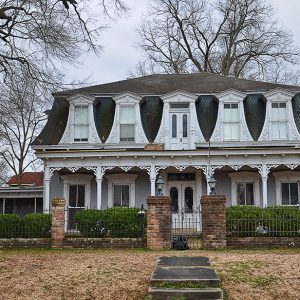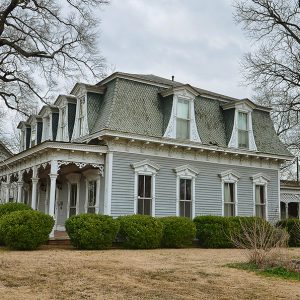calsfoundation@cals.org
Hudson-Grace-Borreson House
aka: Hudson-Grace-Pearson House
The Hudson-Grace-Borreson House, also known as the Hudson-Grace-Pearson House, is located on Barraque Street near historic downtown Pine Bluff (Jefferson County). The house was placed on the National Register of Historic Places on June 24, 1971, due to its architectural significance, as it is a unique blend of Greek Revival, Victorian, and New Orleans French styles. Its occupants over the years were also of historical significance to both the community of Pine Bluff and the state of Arkansas.
The original house was built by William and Jane Woodruff around 1830. The home was designed as having one story, but it was remodeled and expanded to two stories in 1860 by Marion and Emily Hudson. It was purchased at a tax auction in 1868 by W. P. Grace.
The architectural design of the house is significant to the Pine Bluff area because it is a physical representation of the period of transition that was occurring in local architecture. Prior to the 1830s, the Greek Revival style was the clear favorite of wealthy families in the area. However, at this time, the Victorian style was becoming more popular, so this house is a unique combination of both of these styles, with a few additions. The structure also included several elements of the New Orleans French style, as Grace was stationed in New Orleans during the Civil War and admired its architectural style.
The house has been linked to several important figures in Arkansas history. Original builder William Woodruff is best known as the founder of the Arkansas Gazette, the state’s first newspaper. Woodruff became one of the state’s most important historical figures through his other business interests, political connections, and efforts to promote Arkansas. The house’s buyer in 1868, W. P. Grace, was a successful lawyer in Pine Bluff. Grace was born in Kentucky, but after studying with a lawyer in Kentucky, then moving to Florida for a short time, he came to Arkansas and started a law firm with Robert E. Waters. In 1852, he was elected as Pine Bluff’s prosecuting attorney. His local political career gained statewide significance when he and James Yell were chosen as Pine Bluff’s delegates to the first secession convention in Little Rock (Pulaski County) following Abraham Lincoln’s election as president. Grace was chairman of the committee that drew up the Ordinance of Secession that removed Arkansas from the Union. In 1861, he was chosen as Commissary of the Military Staff of Arkansas but only served for a year, as he was in poor health. He then returned to his Pine Bluff law practice and died in 1898. The house was later purchased and resided in for a short time by Ben Pearson, a well-known archer and bow manufacturer.
The home remains privately owned in the twenty-first century.
For additional information:
“Hudson-Grace-Borreson House.” National Register of Historic Places nomination form. On file at Arkansas Historic Preservation Program, Little Rock, Arkansas. Online at http://www.arkansaspreservation.com/National-Register-Listings/PDF/JE0294.nr.pdf (accessed October 6, 2021).
Darby Burdine
White Hall, Arkansas
 Historic Preservation
Historic Preservation Louisiana Purchase through Early Statehood, 1803 through 1860
Louisiana Purchase through Early Statehood, 1803 through 1860 Hudson-Grace-Borreson House
Hudson-Grace-Borreson House  Hudson-Grace-Borreson House Detail
Hudson-Grace-Borreson House Detail  Hudson-Grace-Borreson House Side
Hudson-Grace-Borreson House Side 




Comments
No comments on this entry yet.